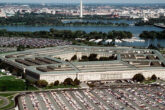February 03, 2021
The Cyber Maritime Environment: A Shared Critical Infrastructure and Trump's Maritime Cyber Security Plan
Last month, the unclassified version of the Donald Trump administration’s Maritime Cybersecurity Plan was published to the White House website … and then summarily taken down, apparently relegated to the trash bin marked “last president’s stuff.”
The plan was roughly 36 pages of mostly overly broad declarations about the insecurity of the seas; the reliance on, and therefore vulnerability of the United States to, maritime hijinks; and a thinly veiled warning about Chinese competitors and port technology. The document is officially dead letter mail, but here is why Washington cannot afford to let the plan’s points of emphasis sink obscurely into the murky ponds of Mar-a-Lago. Whether in competition or in war, the United States is a maritime country. Land security fails without sea supply defense.
The Maritime Cybersecurity Plan provides a basis upon which the Biden administration can build a whole-of-nation defense in a digitalized environment.
The Maritime Cybersecurity Plan provides a basis upon which the Biden administration can build a whole-of-nation defense in a digitalized environment. Yes, it has broad declarations that declare anew work that has long already been in motion for years like “develop risk modeling to inform maritime cybersecurity standards and best practices.” (Hint: It will look a great deal like the current National Institute of Standards and Technology Cybersecurity framework heavily informed by the excellent ongoing and rarely recognized work of the Coast Guard). The work is ongoing but, without the much needed urgency generated by public and policymaker pressure momentum will be lost. The gap between what engineers and maritime transportation experts know and what the policymaker and the public perceives as a cyber threat is a veritable ocean. The intent of the plan was to fire the starting gun for action in a field nearly entirely ignored by most non-maritime techies and policymakers.
Read the full article from War on the Rocks.
More from CNAS
-
The Department of Defense’s Breakthrough Nuclear Moment Risks Slipping Away
Unless they act, the Department of Defense’s breakthrough nuclear moment may vanish before it really happens....
By Will Rogers
-
DEFAERO Strategy Series [Apr 09, 25] CNAS' Becca Wasser and Phil Sheers on Revitalizing the U.S. Defense Industrial Base
On this episode of the Defense & Aerospace Report Strategy Series, sponsored by General Atomics Aeronautical Systems, Becca Wasser and Phil Sheers of the Center for a New Amer...
By Becca Wasser & Philip Sheers
-
From Production Lines to Front Lines
Executive Summary The U.S. defense industrial base (DIB) is struggling to meet the demands of the current strategic environment—let alone prepare for a potential conflict agai...
By Becca Wasser & Philip Sheers
-
The Pentagon’s Endangered Brain Trust
In this environment, sound assessments of emerging threats and new ideas to counter them will be especially vital....
By Dr. Andrew Krepinevich, Jr.




